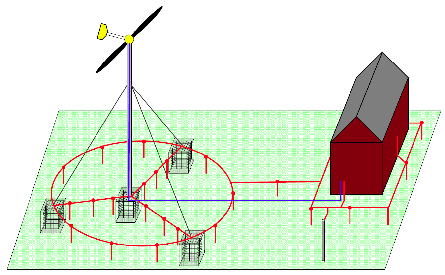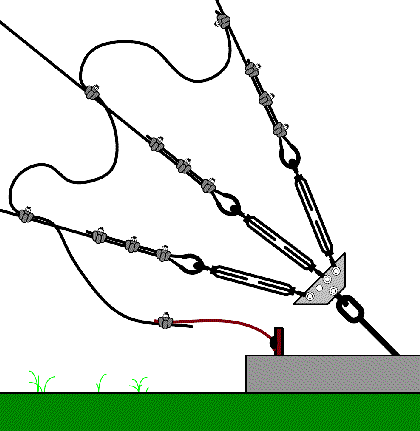Grounding for Lightning
By: Rob Beckers
A good ground is very important, maybe the most important thing, in mitigating lightning damage; the more energy you can divert to ground before it gets into the house or equipment room, the less you have to deal with through lightning and surge arrestors. More importantly, more energy diverted to ground means less can go through your electronics!
A lightning strike moves a massive amount of electrical charge around, and a single grounding point is not going to be able to cope with that flow. Even a few closely spaced ground rods are not really going to cut it; all those electrons need some space to fan out and disperse to ground. Here is what the pros do: They run a star-shaped network of flat copper strap fanning out from the tower, with ground rods spaced along (and tied into the ribbon) at twice the length of the rod. So, for 10 feet ground rods they are spaced 20 feet apart. The reason for using a copper strap is that even though lightning is in essence a direct-current event (most of the time the cloud is negative, the ground positive), there is considerable high-frequency energy involved as well and it tends to stay at the surface of a conductor (“skin effect”). Because of that, a flat copper strap of at least 1-1/2″ width and at least #26 AWG (0.0179″) thickness has less impedance (the resistance for high-frequency energy) than a #4/0 AWG (0.46″) round copper conductor.
The copper radials should be buried at least 8″ and preferably 18″ or more underground. A radial in wet soil will work better than the same radial in dry soil. There is also a maximum length where the radial’s impedance will prevent any additional electrical charge from traveling further down the line. Short radials do not work very well either, because of the same charge saturation problem mentioned before. A good radial is at least 50 feet, and no more than 75 feet long. If a radial comes within 4 feet of a metal object, that object should be electrically connected to the radial. More radials is certainly better, but after 4 radials one enters the domain of diminishing returns. Keep in mind that radials do not need to go in a straight line. Gradual bends around obstacles or to follow the terrain are fine.
Sharp bends add inductance, and will cause lightning to look for an easier way to get to ground. Any conductor that is going to carry lightning current should therefore have a bending radius of no less than 8″. This is not the place for neat, 90-degree angle installations. Gentle curves is what works best.
Ground rods in a well-conducting soil have a cylindrical region of influence around them with a diameter that extends roughly twice the length of the ground rod. This is the region in which the ground rod disperses lightning strike energy. Placing round rods closer together than twice their length means their regions of influence overlap. That does not make it a worse grounding system, but there is no gain either and it is a waste of money to place them that close together. So, for 8 foot ground rods they should be 16 feet apart, for 10 foot rods it becomes 20 feet from one rod to the next. The ground rods themselves should be copper clad. There are several reasons for this: The copper cladding makes them last longer underground than bare steel or galvanized rods (stainless rods will last longer still, but they are also much more expensive). What is more, the ground strap or wire is going to be made from copper, and connecting that with a bare steel or galvanized ground rod creates a battery that will quickly consume the steel or galvanized rod through galvanic action. A copper clad ground rod will prevent this from happening, and again, make it last longer. The saying in the business is that the best resistance-to-ground you are going to see from a ground rod is right after installation, it is downhill from there.
Just in case that was not obvious; Ground rods and their connecting ground wires are normally kept fully underground. So, dig a hole before pounding in the ground rod, and drive it below ground level. Grounding wires should be underground in trenches (and backfilled). In fact, for optimal effect the wires of your ground radials should be 18″ underground. Not only will this look better, and keep your lawn tractor from mauling its blade, it will also be electrically more effective.
If possible, the ground rods should use exothermic bonds to connect to the grounding strap or wire (“Cadweld” and “thermOweld” are often used brand-names for exothermic welds). Those last far longer with more predictable and lower connection resistance than the next-best alternative, high-pressure clamps and joint compound (anti-corrosion compound). According to the pros you should inspect high-pressure clamps annually, if you use them. Not easy to do when they are underground. Brazing is an allowed substitute for exothermic welds, though this is a skill that not many can do well.
If you are lucky enough to have a well close to your tower, be sure to tie it into your grounding system. A steel well casing makes an excellent ground! This only works for metal well casings. The newer plastic casings are of no use for grounding.
A grounding system of multiple radials does not have to be ‘in the horizontal’. There are special 50 feet long ground rods (or regular rods with couplers) that are used to make a vertical grounding system. When done properly this works just as well, though installation requires professional equipment. The above link also shows the effects of both the lack of a proper grounding system, and the difference this can make.
All the above assumes you are able to dig into the ground, and install ground radials plus ground rods. If you have rock to deal with, or very dry (non-conductive) soil you should talk to a professional and find the best option for your particular case. Ufer-grounds can be a solution.
Tower-to-Ground Connections
Now that we have covered the part that goes into the ground it is time to take a closer look at the wind turbine tower itself. Here is something that is not needed: There is no point in running a grounding wire from the top of the tower to the bottom. Studies show no benefit. While steel is not as conductive as copper, there is so much of it and with such a large surface area that adding a grounding wire along the tower has no benefit. What is more, the unavoidable leaching of copper ions from a bare copper grounding wire would dissolve zinc from the galvanized tower, causing it to start rusting that much sooner.
A self-support tower should be grounded at every ‘leg’ of the tower. So if it is a triangular tower, that means three straps running from the tower leg to your grounding system. Guyed towers make grounding a little bit easier, since the guy wires tend to divide up the electrical energy of a lightning strike. Each guy point needs to be grounded, as well as the tower base itself. Use #4 AWG (or larger) bare copper wire to make the connection with your grounding system. If this wire is going below ground, use single strand (solid) wire.
It is a good idea to not directly connect copper to galvanized steel. The connection is prone to corrosion, undoing all your good work. Often an intermediate metal such as stainless steel is used, and there are specialized clamps that achieve the same result. Either way, use lots of anti-corrosion compound to keep water out and slow down corrosion.
For guyed towers each guy wire needs to be connected to ground, preferably before the turnbuckles. Especially with guy wires it is a bad idea to directly connect copper wire to the galvanized guy wires. This is one place you do not want to encourage corrosion and weaken the structure! The trick to avoiding this is by taking an extra piece of guy wire, and stringing it from guy to guy using wire rope clips to attach it to each guy wire and to the grounding wire. Once again, gentle turns, and anti-corrosion compound is your friend. See the drawing on the right. Please note that the the drawing shows grounding only. It is not meant to show how to properly install guy wires (for one, the turnbuckles and thimbles are not locked in place, a wire is supposed to run through them to prevent turning). What the drawing also does not show is that by moving the wire clips up a little with each higher guy wire you can eliminate a turn in the wire, making it work just a little bit better as a grounding wire.
To complete the grounding system, run ground wire from all 4 guy points to the center foundation block, 18″ underground, and add a ground rod every 20′ along the wire (and connect all together). Forming a big “X” ground radial system. If you want to improve this or get fancy you can run a grounding wire underground around the 4 guy points as a type of perimeter ground.
Ufer Ground
It turns out that a block of reinforced concrete in the ground make an excellent electrical ground all by itself. Even in sandy or dry soils! This has something to do with the large surface area of concrete (it’s rough and somewhat porous) and the salts in it that disperse to make the surrounding soil more conductive. An engineer named Herbert Ufer found this out for the US army during World War II, where they needed to ground ammunition bunkers. It’s therefore called a “Ufer ground”. What do you know: There is lots of concrete in the foundation of a wind turbine tower! It does not happen often, but here we can get something for nothing by planning it right.
What needs to be done different from a regular foundation is that all the rebar and any anchors/J-bolts need to be electrically bonded together (and bonded well, not just with a little steel wire). Not doing so runs the risk of flash-over inside the concrete, possibly causing cracks by turning moisture in the concrete into instant steam. The easiest way to connect everything together is by welding it, just a tack is fine, this is not structural. All rebar should have at least 4″ of concrete around it. This avoids hot spots where lightning current could spark directly to ground, with the potential of causing cracks.
At the same time also connect some solid copper wire (at least #4 AWG) to the rebar and have it come out the top, for connecting all grounding points together. As long as the copper is connected inside the concrete there won’t be any galvanic corrosion (it has to be solid wire though, stranded wire will wick moisture into the concrete causing it to crack when it freezes). Once again, the grounding wire should ideally be bonded with an exothermic weld. A suggestion that may be easier to work with is to weld a section of copper-clad ground rod to the rebar and have this come out the top of the concrete. Then bond your grounding wires to the rod using exothermic welds.
It is preferable that the foundation/anchor blocks are cast directly into the earth, without using forms. From a mechanical point of view this gives superior stability of the foundation. From an electrical point of view the undisturbed soil is a much better conductor than backfilled soil. Besides, it saves you the trouble of creating casting forms. Just be careful when digging the holes not to over-dig them, and you are off to the races. If you must use casting forms be sure to remove them after casting! The same goes for any polyethylene sheets. Your concrete will be useless as a Ufer ground if the form or plastic sheeting is still around it.
Perimeter Ground
Every house requires a ground, it is an electrical code requirement. That ground is connected to the house ground in the breaker box. It is there to provide a safety ground for the grid, it is not there for lightning protection, and will in fact do little or nothing in that regard. Now we have the tower ground coming in on one side of the house, the original house safety ground on the other. What do you think will happen when lightning strikes the turbine tower? A very large amount of current is going to disperse through the ground in all directions, including the direction of your house, and both sides of that house will be at a very different ground potential (voltage). This will cause current to flow through the wiring of your house, from one ground to the other, and if there are any electronics in between then Murphy’s law dictates that this current will flow through the most expensive electronic bits to cause maximum damage (letting the magic smoke out in the process)! This is where a perimeter ground comes in to prevent damage.
Electrical code also requires that you electrically bind all grounds together. It is just that you do not want to do this through the wiring (even grounding wires) inside your house. For this reason the pros run a buried ground strap or wire around the the structure (house, commercial building, equipment shack etc.). Along the ground strap there are more ground rods, spaced at twice the rod length. Just like the grounding radials of the tower. This perimeter ground then ties in with the other ground wiring of the structure, the house ground and/or the inverter ground.
Just like the grounding radials of the tower, the perimeter ground should be buried at least 8″, and preferably 18″ deep. Ground rods should use exothermic welds to the perimeter ground strap or wire, for optimal durability and reliability. The same rules as previously mentioned apply here as well.
 Of course, not everyone has the means to install a perimeter ground. Not only for financial reasons, but there may also be structural obstacles such as a driveway that prevent the perimeter ground from going all the way around. If this is the case, keep in mind that even a partial perimeter ground is better than none at all.
Of course, not everyone has the means to install a perimeter ground. Not only for financial reasons, but there may also be structural obstacles such as a driveway that prevent the perimeter ground from going all the way around. If this is the case, keep in mind that even a partial perimeter ground is better than none at all.
The image on the left shows a general overview of what a grounding network would look like. By clicking on the image you can download an annotated PDF that has more detailed information.






